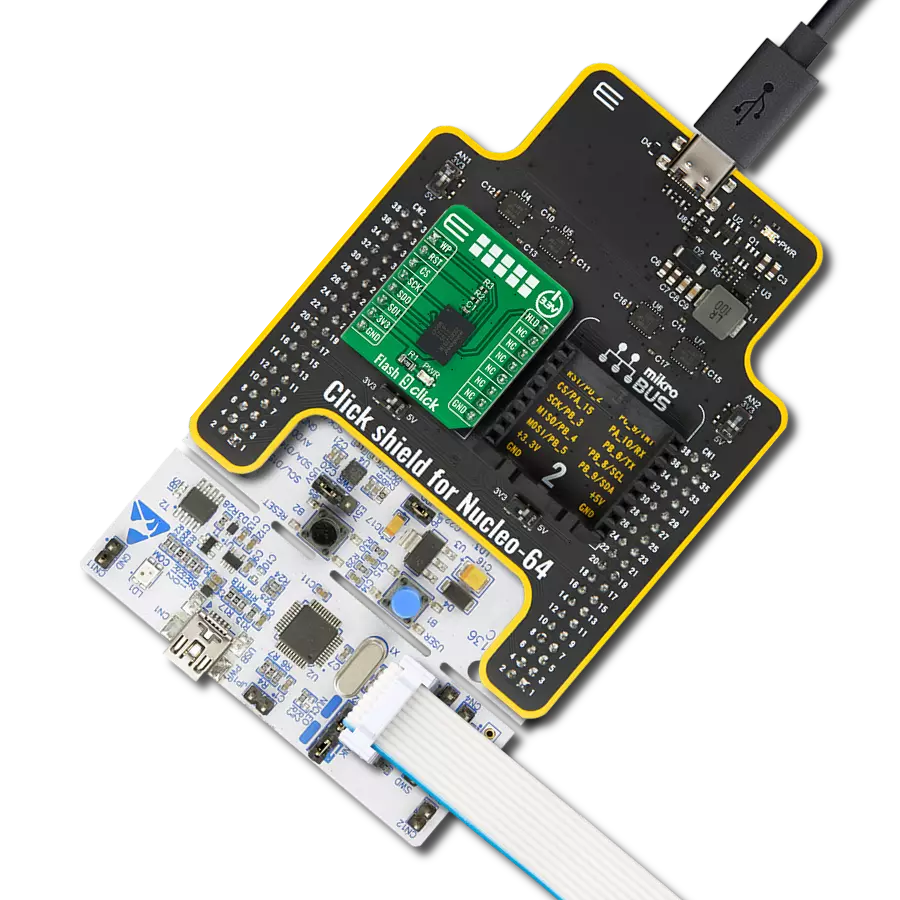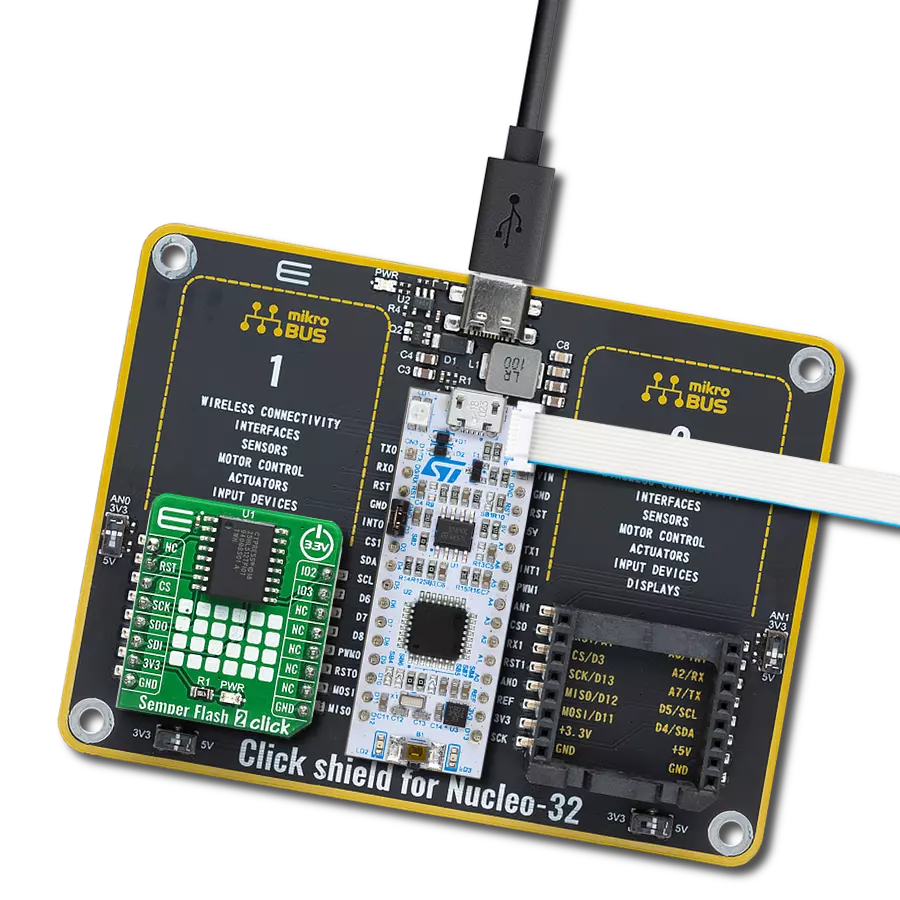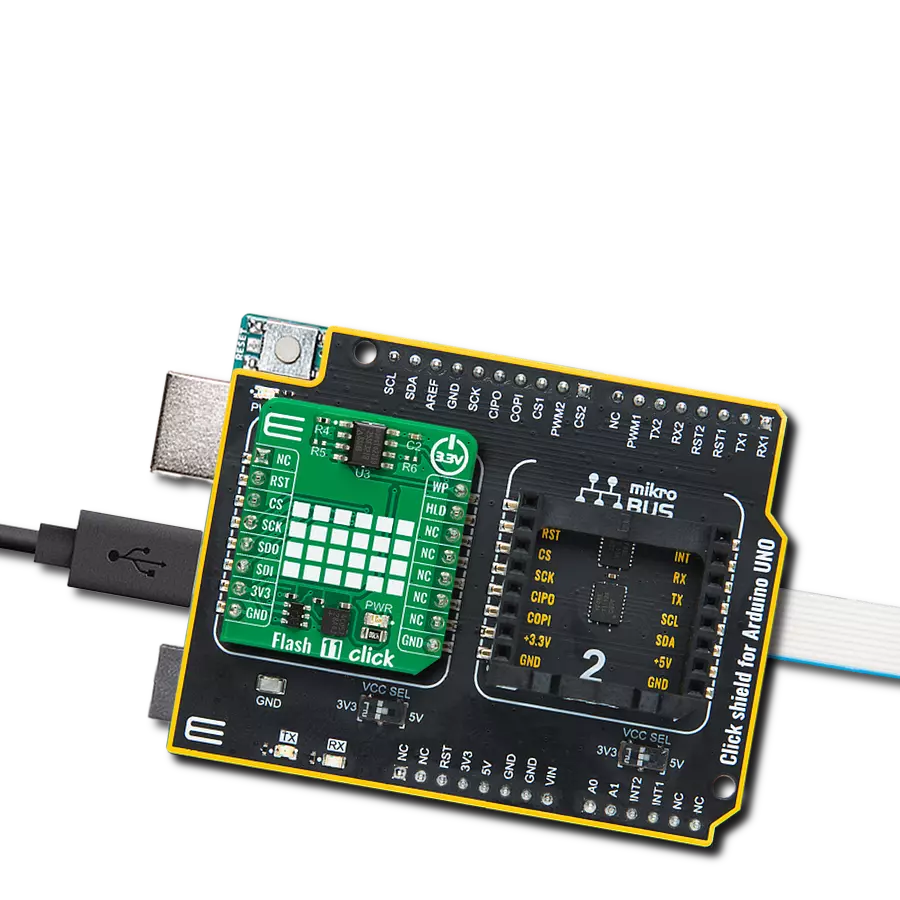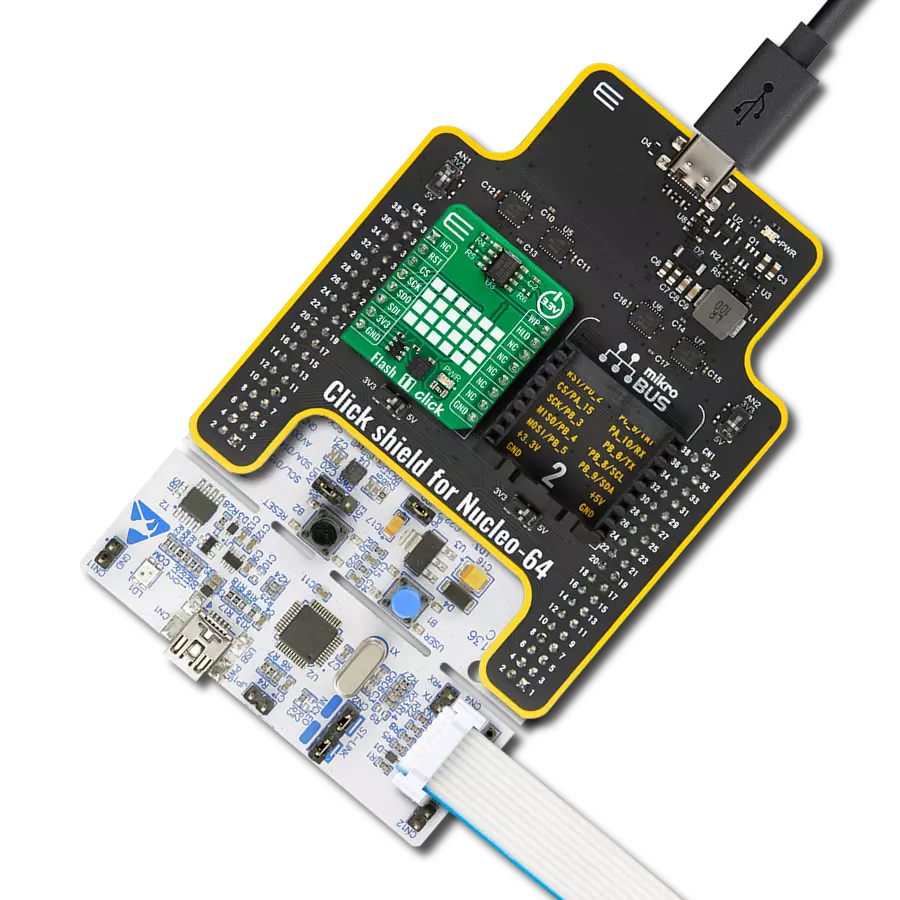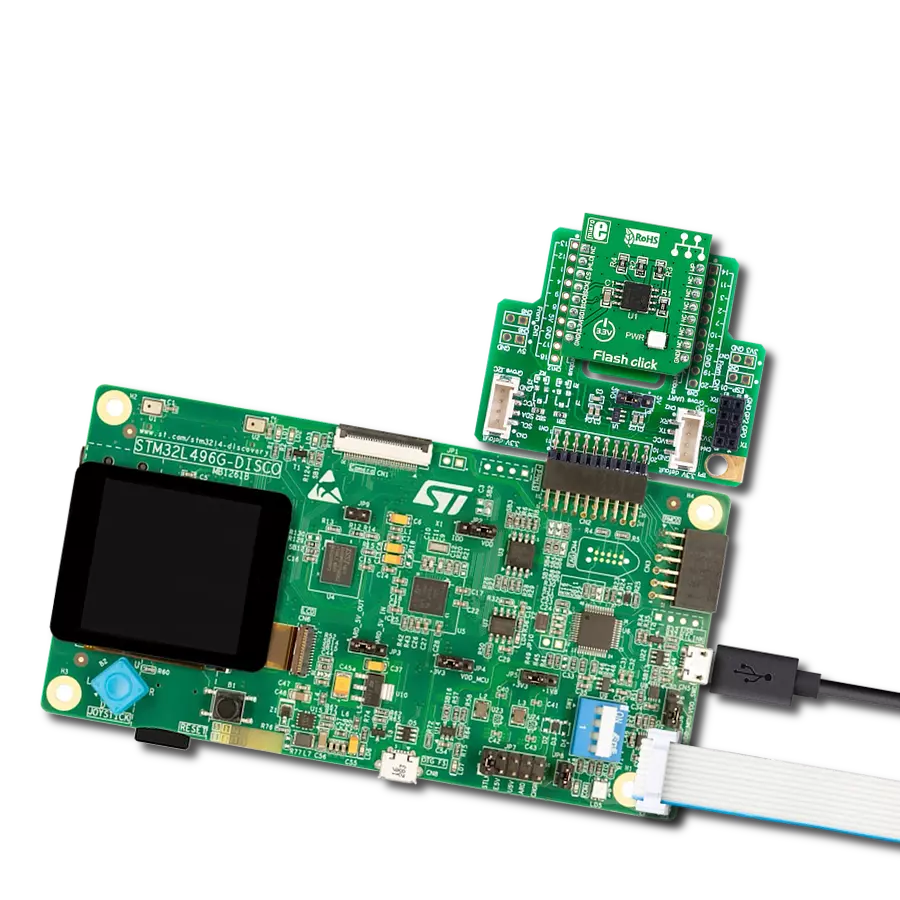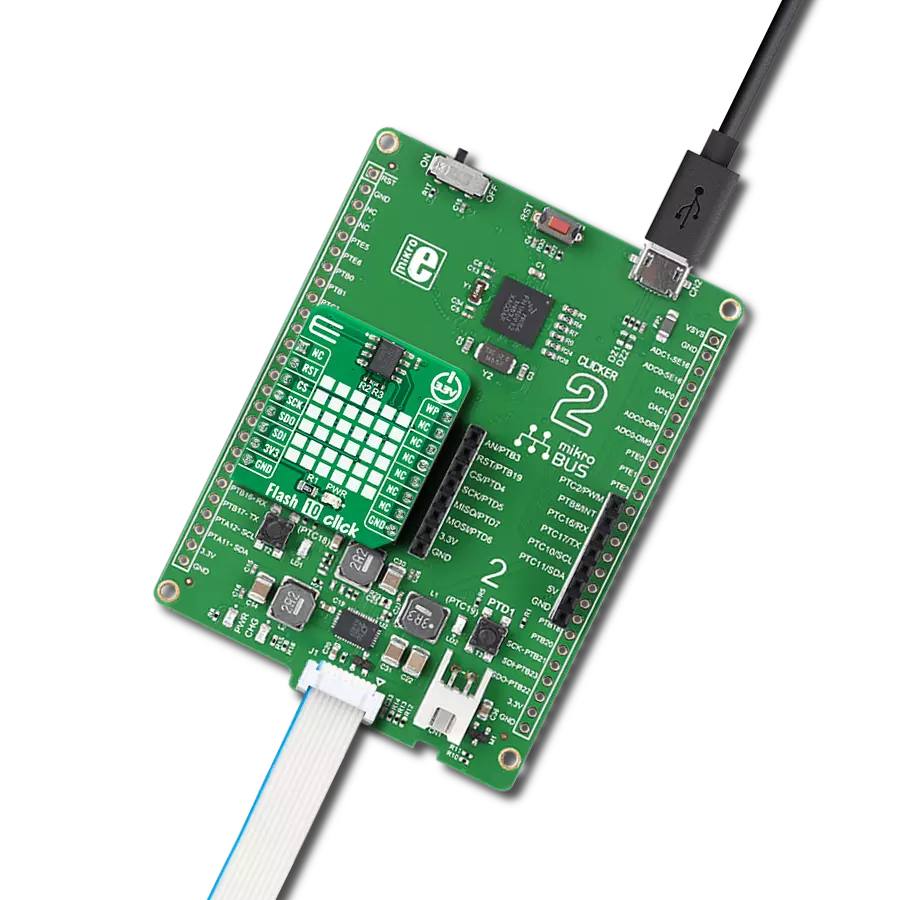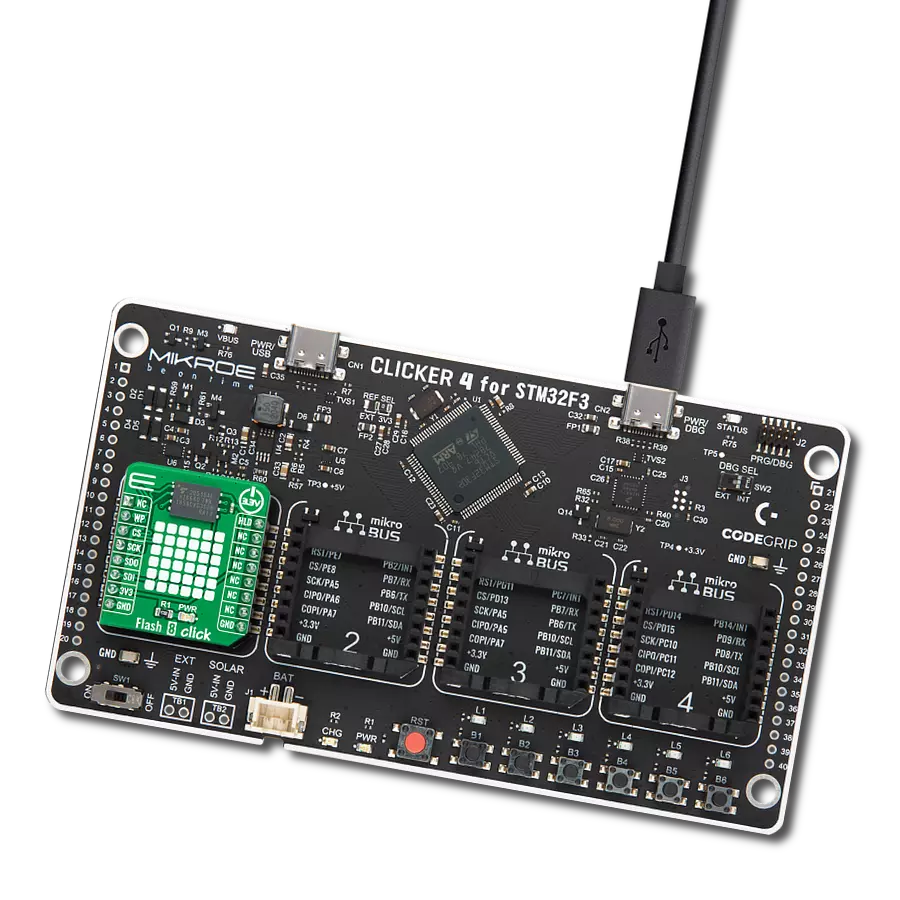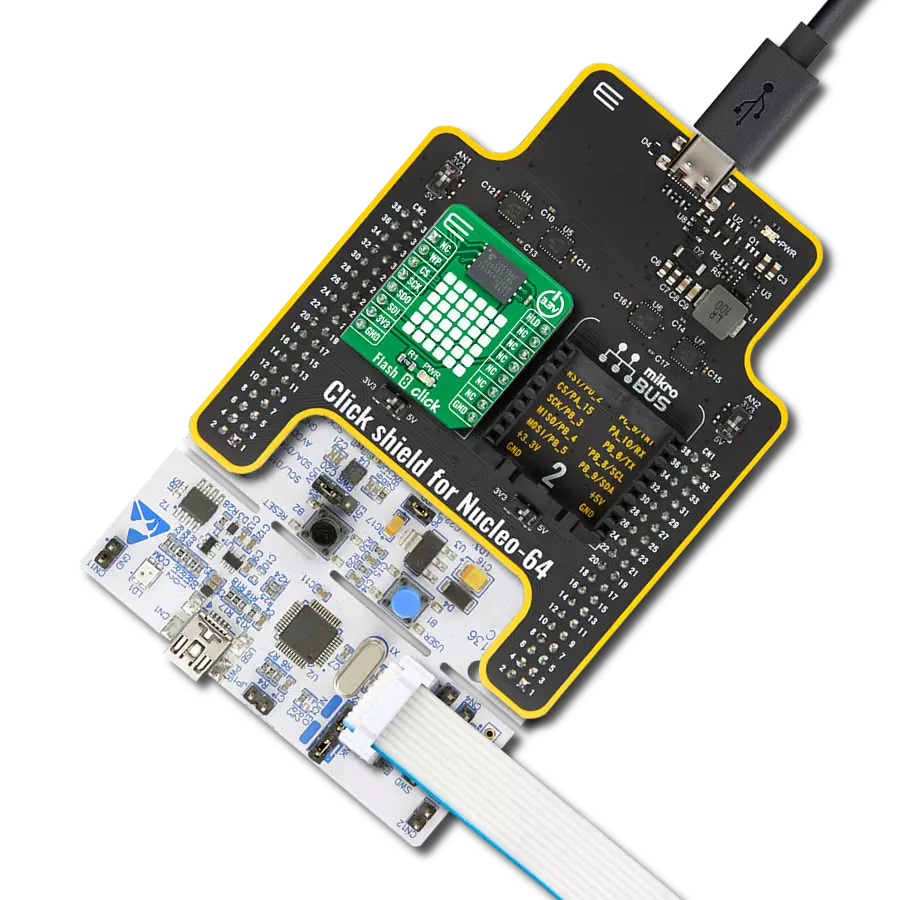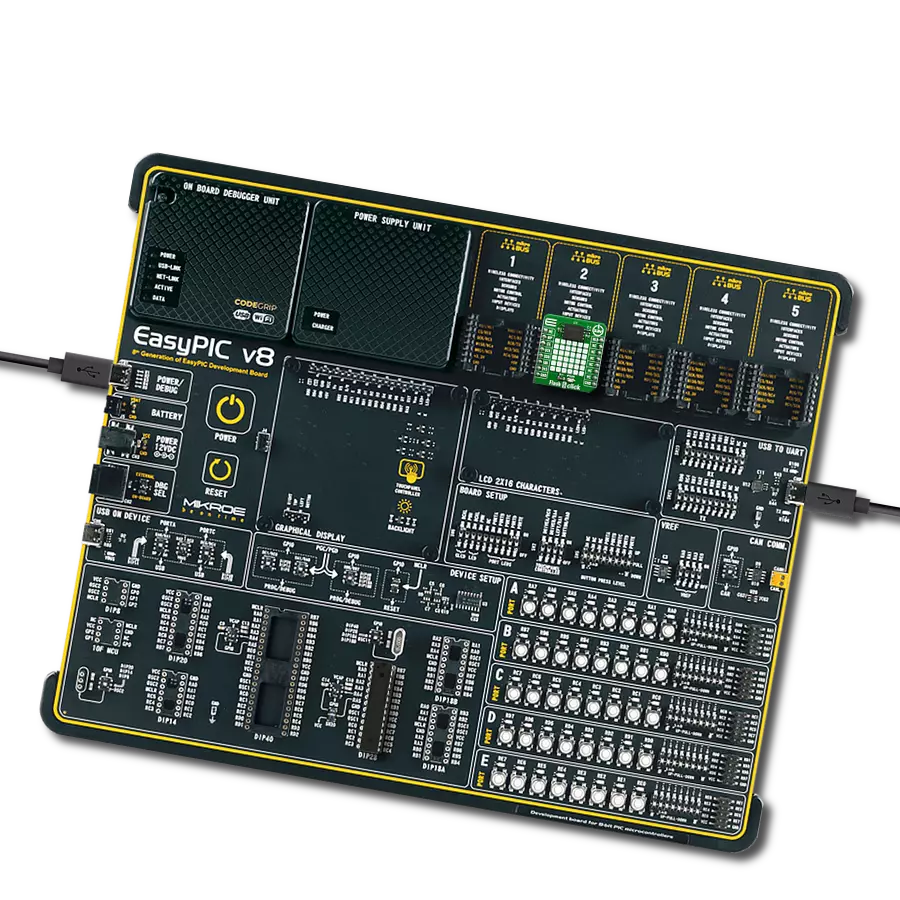Add fast, reliable, and secure SPI Flash storage to embedded apps for high-speed data retention and execution-in-place capability
A
A
Hardware Overview
How does it work?
Flash 13 Click is based on the BY25Q16E, a 16Mbit SPI NOR Flash memory from BYTe Semiconductor. This memory supports a range of communication modes including standard SPI, Dual/Quad I/O SPI, and a 2-clock instruction cycle Quad Peripheral Interface (QPI), offering flexibility for embedded applications. With SPI clock frequencies reaching up to 108MHz, the BY25Q16E can achieve data transfer rates of up to 216MHz in Dual I/O mode and an impressive 432MHz in Quad I/O mode when utilizing Fast Read or QPI instructions. These high-speed operations enable performance levels that surpass those of traditional asynchronous 8-bit and 16-bit parallel flash memories, making it suitable for demanding commercial and industrial use cases that demand fast access, secure storage, and extended operational lifetime. The BY25Q16E offers high endurance with a typical lifespan of 100,000 program-erase cycles per sector and long-term reliability with a typical data retention period of 20 years. One of the standout features of the BY25Q16E is its Continuous Read Mode, which enables quick memory access by requiring just 8
clock cycles to read a 24-bit address. This capability makes true XIP (execute in place) operations possible, significantly optimizing system performance where direct code execution from Flash is required. The device also adheres to JEDEC standards by supporting standard manufacturer and device ID protocols, and it incorporates three security registers of 1024 bytes each for data protection and secure storage requirements. This Click board™ is designed in a unique format supporting the newly introduced MIKROE feature called "Click Snap." Unlike the standardized version of Click boards, this feature allows the main chip area to become movable by breaking the PCB, opening up many new possibilities for implementation. Thanks to the Snap feature, the BY25Q16E can operate autonomously by accessing their signals directly on the pins marked 1-8. Additionally, the Snap part includes a specified and fixed screw hole position, enabling users to secure the Snap board in their desired location. Flash 13 Click communicates with MCU through a standard SPI interface supporting the two most common SPI modes, SPI Mode 0 and 3, and
a maximum clock frequency of up to 108MHz. The BY25Q16E enhances data transfer rates through Dual and Quad SPI operations, which double and quadruple the standard SPI speed, respectively. These enhanced speeds are achieved by re-purposing the available pins as bidirectional I/O pins during Dual and Quad SPI operations. Furthermore, the board features a HOLD function, marked as HLD and routed on the default position of the PWM pin of the mikroBUS™ socket. The hold function allows the suspension of serial communications without disrupting ongoing operations. The board also has a Write Protect feature, marked as WP and routed on the default position of the AN of the mikroBUS™ socket, that safeguards all registers and memory from unintended write operations through both hardware and software mechanisms. This Click board™ can be operated only with a 3.3V logic voltage level. The board must perform appropriate logic voltage level conversion before using MCUs with different logic levels. It also comes equipped with a library containing functions and example code that can be used as a reference for further development.
Features overview
Development board
PIC18F57Q43 Curiosity Nano evaluation kit is a cutting-edge hardware platform designed to evaluate microcontrollers within the PIC18-Q43 family. Central to its design is the inclusion of the powerful PIC18F57Q43 microcontroller (MCU), offering advanced functionalities and robust performance. Key features of this evaluation kit include a yellow user LED and a responsive
mechanical user switch, providing seamless interaction and testing. The provision for a 32.768kHz crystal footprint ensures precision timing capabilities. With an onboard debugger boasting a green power and status LED, programming and debugging become intuitive and efficient. Further enhancing its utility is the Virtual serial port (CDC) and a debug GPIO channel (DGI
GPIO), offering extensive connectivity options. Powered via USB, this kit boasts an adjustable target voltage feature facilitated by the MIC5353 LDO regulator, ensuring stable operation with an output voltage ranging from 1.8V to 5.1V, with a maximum output current of 500mA, subject to ambient temperature and voltage constraints.
Microcontroller Overview
MCU Card / MCU
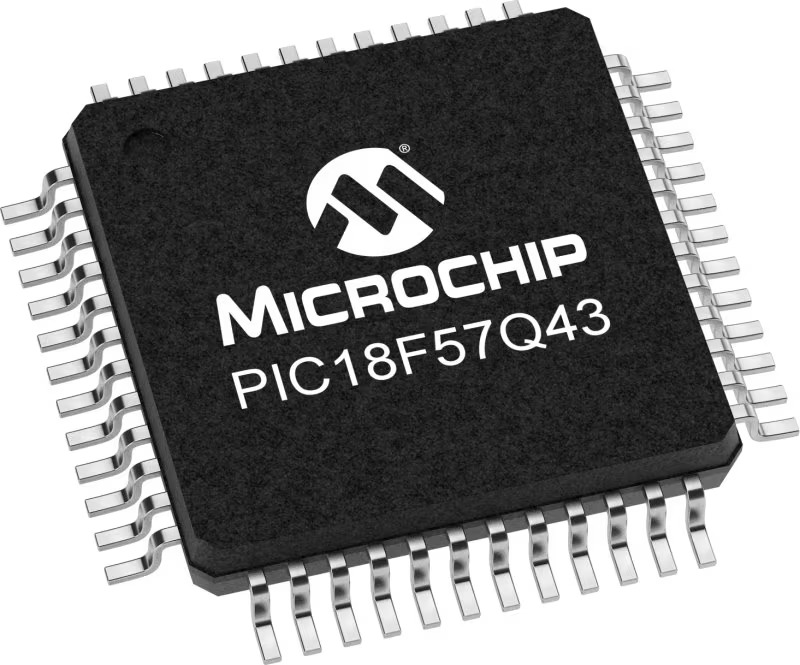
Architecture
PIC
MCU Memory (KB)
128
Silicon Vendor
Microchip
Pin count
48
RAM (Bytes)
8196
You complete me!
Accessories
Curiosity Nano Base for Click boards is a versatile hardware extension platform created to streamline the integration between Curiosity Nano kits and extension boards, tailored explicitly for the mikroBUS™-standardized Click boards and Xplained Pro extension boards. This innovative base board (shield) offers seamless connectivity and expansion possibilities, simplifying experimentation and development. Key features include USB power compatibility from the Curiosity Nano kit, alongside an alternative external power input option for enhanced flexibility. The onboard Li-Ion/LiPo charger and management circuit ensure smooth operation for battery-powered applications, simplifying usage and management. Moreover, the base incorporates a fixed 3.3V PSU dedicated to target and mikroBUS™ power rails, alongside a fixed 5.0V boost converter catering to 5V power rails of mikroBUS™ sockets, providing stable power delivery for various connected devices.
Used MCU Pins
mikroBUS™ mapper
Take a closer look
Click board™ Schematic
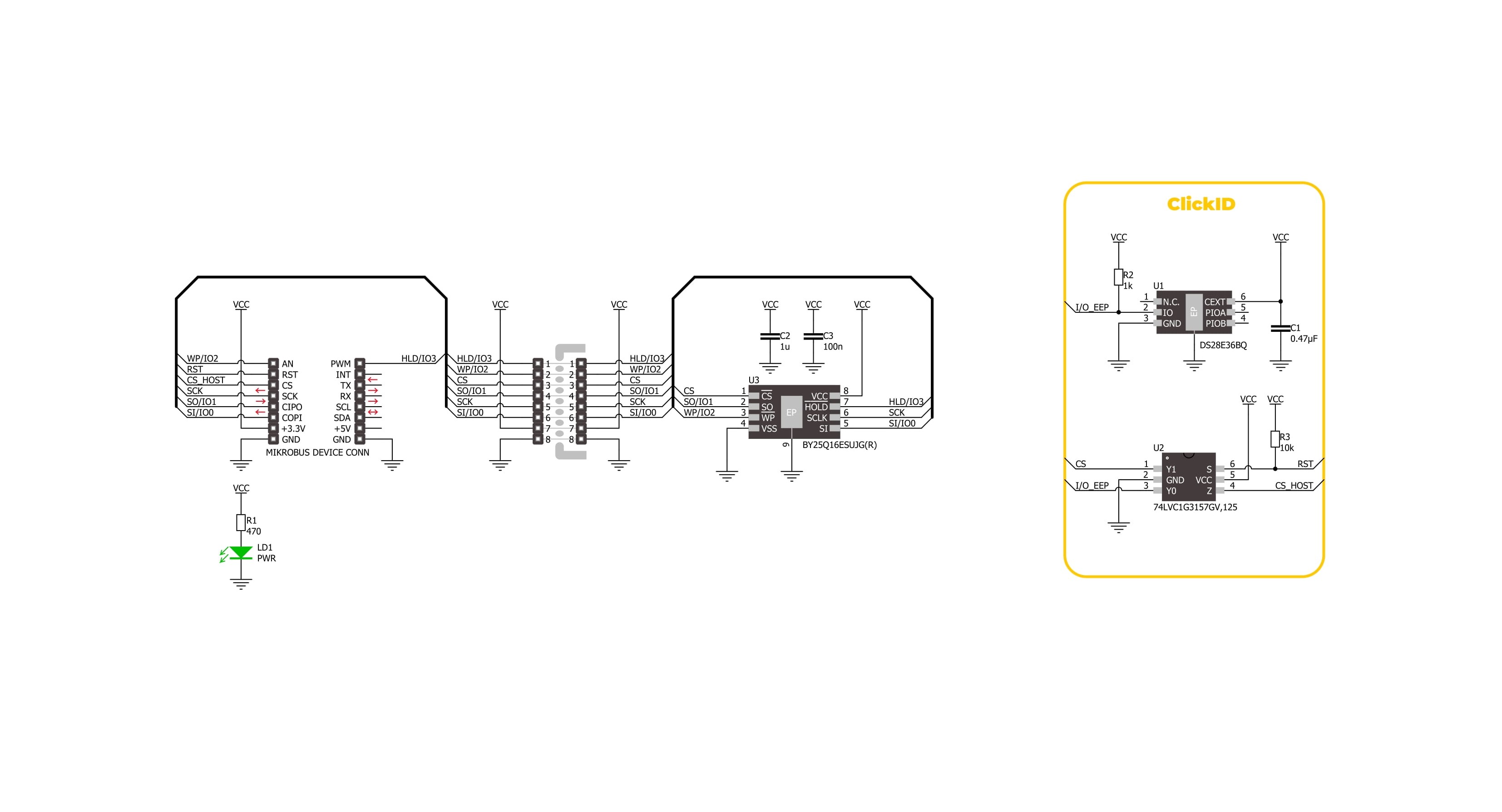
Step by step
Project assembly
Software Support
Library Description
Flash 13 Click demo application is developed using the NECTO Studio, ensuring compatibility with mikroSDK's open-source libraries and tools. Designed for plug-and-play implementation and testing, the demo is fully compatible with all development, starter, and mikromedia boards featuring a mikroBUS™ socket.
Example Description
This example demonstrates the use of Flash 13 Click board by writing specified data to the memory and reading it back.
Key functions:
flash13_cfg_setup- This function initializes Click configuration structure to initial values.flash13_init- This function initializes all necessary pins and peripherals used for this Click board.flash13_erase_memory- This function erases the selected amount of memory which contains the selected address.flash13_memory_write- This function writes a desired number of data bytes starting from the selected memory address.flash13_memory_read- This function reads a desired number of data bytes starting from the selected memory address.
Application Init
Initializes the driver and checks the communication by reading and verifying the device ID.
Application Task
Writes a desired number of bytes to the memory and then verifies if it is written correctly by reading from the same memory location and displaying the memory content on the USB UART. The whole 4KB sector of memory that contains the STARTING_ADDRESS will be erased before writing data.
Open Source
Code example
The complete application code and a ready-to-use project are available through the NECTO Studio Package Manager for direct installation in the NECTO Studio. The application code can also be found on the MIKROE GitHub account.
/*!
* @file main.c
* @brief Flash 13 Click example
*
* # Description
* This example demonstrates the use of Flash 13 Click board by writing specified data to
* the memory and reading it back.
*
* The demo application is composed of two sections :
*
* ## Application Init
* Initializes the driver and checks the communication by reading and verifying the device ID.
*
* ## Application Task
* Writes a desired number of bytes to the memory and then verifies if it is written correctly
* by reading from the same memory location and displaying the memory content on the USB UART.
* The whole 4KB sector of memory that contains the STARTING_ADDRESS will be erased before writing data.
*
* @author Stefan Filipovic
*
*/
#include "board.h"
#include "log.h"
#include "flash13.h"
#define DEMO_TEXT_MESSAGE_1 "MIKROE"
#define DEMO_TEXT_MESSAGE_2 "Flash 13 Click"
#define STARTING_ADDRESS 0x012345ul
static flash13_t flash13;
static log_t logger;
void application_init ( void )
{
log_cfg_t log_cfg; /**< Logger config object. */
flash13_cfg_t flash13_cfg; /**< Click config object. */
/**
* Logger initialization.
* Default baud rate: 115200
* Default log level: LOG_LEVEL_DEBUG
* @note If USB_UART_RX and USB_UART_TX
* are defined as HAL_PIN_NC, you will
* need to define them manually for log to work.
* See @b LOG_MAP_USB_UART macro definition for detailed explanation.
*/
LOG_MAP_USB_UART( log_cfg );
log_init( &logger, &log_cfg );
log_info( &logger, " Application Init " );
// Click initialization.
flash13_cfg_setup( &flash13_cfg );
FLASH13_MAP_MIKROBUS( flash13_cfg, MIKROBUS_1 );
if ( SPI_MASTER_ERROR == flash13_init( &flash13, &flash13_cfg ) )
{
log_error( &logger, " Communication init." );
for ( ; ; );
}
if ( FLASH13_ERROR == flash13_check_communication ( &flash13 ) )
{
log_error( &logger, " Check communication." );
for ( ; ; );
}
log_info( &logger, " Application Task " );
}
void application_task ( void )
{
uint8_t data_buf[ 128 ] = { 0 };
log_printf ( &logger, " Memory address: 0x%.6LX\r\n", ( uint32_t ) STARTING_ADDRESS );
if ( FLASH13_OK == flash13_erase_memory ( &flash13, FLASH13_CMD_SECTOR_ERASE_4KB, STARTING_ADDRESS ) )
{
log_printf ( &logger, " Erase memory block (4KB)\r\n" );
}
memcpy ( data_buf, DEMO_TEXT_MESSAGE_1, strlen ( DEMO_TEXT_MESSAGE_1 ) );
if ( FLASH13_OK == flash13_memory_write ( &flash13, STARTING_ADDRESS, data_buf, sizeof ( data_buf ) ) )
{
log_printf ( &logger, " Write data: %s\r\n", data_buf );
Delay_ms ( 100 );
}
memset ( data_buf, 0, sizeof ( data_buf ) );
if ( FLASH13_OK == flash13_memory_read ( &flash13, STARTING_ADDRESS, data_buf, sizeof ( data_buf ) ) )
{
log_printf ( &logger, " Read data: %s\r\n\n", data_buf );
Delay_ms ( 1000 );
Delay_ms ( 1000 );
Delay_ms ( 1000 );
}
log_printf ( &logger, " Memory address: 0x%.6LX\r\n", ( uint32_t ) STARTING_ADDRESS );
if ( FLASH13_OK == flash13_erase_memory ( &flash13, FLASH13_CMD_SECTOR_ERASE_4KB, STARTING_ADDRESS ) )
{
log_printf ( &logger, " Erase memory block (4KB)\r\n" );
}
memcpy ( data_buf, DEMO_TEXT_MESSAGE_2, strlen ( DEMO_TEXT_MESSAGE_2 ) );
if ( FLASH13_OK == flash13_memory_write ( &flash13, STARTING_ADDRESS, data_buf, sizeof ( data_buf ) ) )
{
log_printf ( &logger, " Write data: %s\r\n", data_buf );
Delay_ms ( 100 );
}
memset ( data_buf, 0, sizeof ( data_buf ) );
if ( FLASH13_OK == flash13_memory_read ( &flash13, STARTING_ADDRESS, data_buf, sizeof ( data_buf ) ) )
{
log_printf ( &logger, " Read data: %s\r\n\n", data_buf );
Delay_ms ( 1000 );
Delay_ms ( 1000 );
Delay_ms ( 1000 );
}
}
int main ( void )
{
/* Do not remove this line or clock might not be set correctly. */
#ifdef PREINIT_SUPPORTED
preinit();
#endif
application_init( );
for ( ; ; )
{
application_task( );
}
return 0;
}
// ------------------------------------------------------------------------ END
Additional Support
Resources
Category:FLASH






















